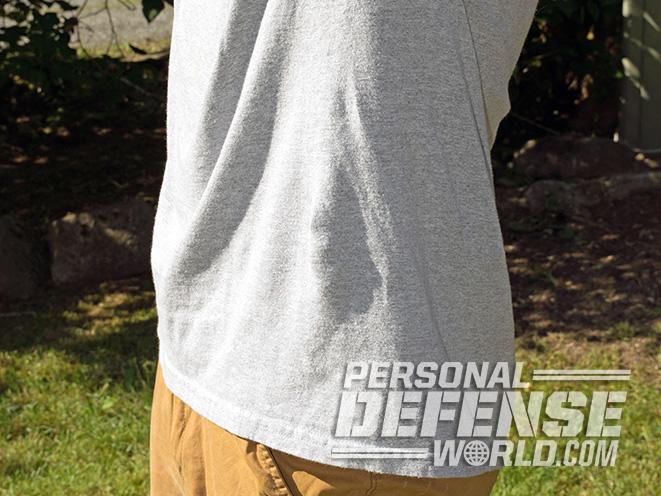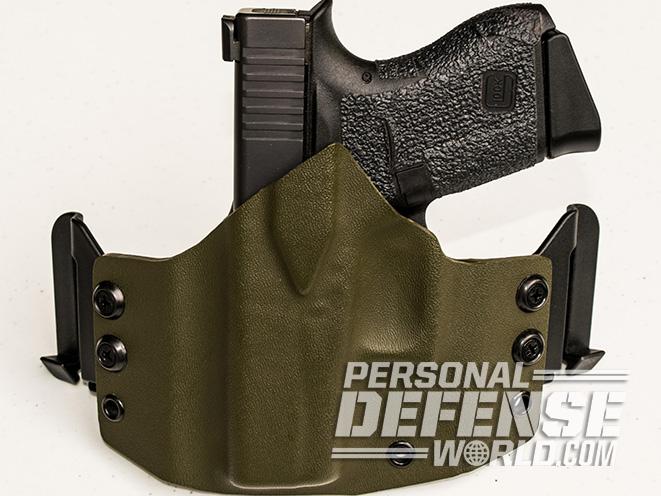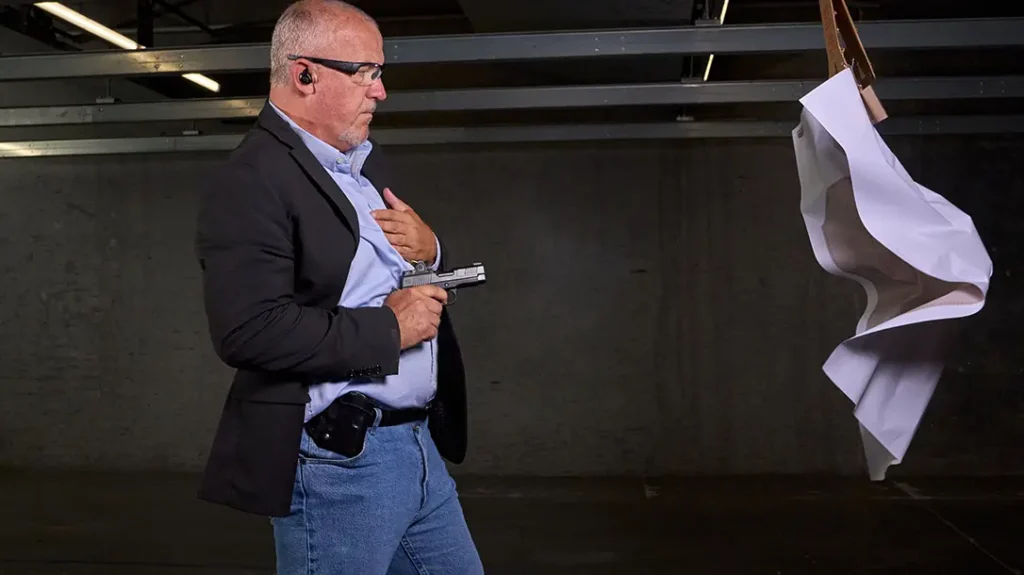Have you looked at a huge selection of concealment holsters and felt overwhelmed? Depending on your handgun’s make and model, the choice can be intimidating. You want to select a concealment holster that suits your needs. Hopefully, this article can help you better understand the wide variety of concealment holster models currently available. Not all rigs are created equal. You want one that fits your body type, preferred carry method and desired level of retention. And the cliché that you get what you pay for rings true.
Various Types
With so many concealment holster rigs available, how do you know which one is right? This debate will continue endlessly. There are many types of holsters, including pocket, shoulder, ankle, appendix, outside-the-waistband (OWB), inside-the-waistband (IWB) and small-of-the-back (SOB) models. Manufacturers even offer holsters that attach to a woman’s bra and one that attaches to your underwear.
There are also security-type holsters that offer retention to ward off being disarmed by an attacker (think police-type holsters). So, wondering where you’re going to strap your heater to your body isn’t much of a problem anymore thanks to advances in concealment holster technology.
Let’s take a closer look.
Advertisement — Continue Reading Below
- RELATED STORY: 7 Critical Things to Consider with Off-Body Carry
Most longtime shooters have a drawer full of holsters. I try to keep most of my holsters made of the same type of material and retention, regardless if I’m carrying inside the waistband or outside the waistband. Holsters come in many forms: Kydex, leather, nylon and other materials. Kydex is a type of hard yet somewhat pliable polymer. Most of my holsters are made of some kind of Kydex and will lock the pistol in place.
It’s also wise to try to position your holster in the same place every time you put it on. This is very important because you will develop muscle memory through time. After training and developing that muscle memory, you should instinctually go to that spot every time to draw your pistol.
Because I spent most of my adult life as a deputy sheriff and I’m left-handed, I carry on my strong side at the 9 o’clock position or slightly behind that at the 7:30 to 8 o’clock positon. I developed that muscle memory through many years of training, so I carry on my strong side or just slightly behind it. Now let’s discuss some of the most common concealed-carry methods.
Advertisement — Continue Reading Below
Outside The Waistband
OWB carry probably allows for the greatest amount of flexibility. This is also the most common type of holster. Most of the Kydex types have an option that lets you adjust the cant, or angle, at which the pistol rides in the holster. When ordering one of these rigs, make sure to measure the width of the belt on which you plan to carry it. That way you can ensure that your belt will slide comfortably through the attachment loops of the holster.
Inside The Waistband
IWB carry offers the greatest anonymity when carrying concealed. Companies such as Clinger, Vedder, Alien Gear, CrossBreed, G-Code and Theis produce models that let you tuck your shirt in over the holster and be nearly invisible, except for a clip on your belt. This method can also increase wardrobe costs. You’ll want to wear pants, shorts and belts that are at least once size larger when going this route with an IWB rig. Otherwise, you’ll be miserable, especially if
you enjoy a spicy lunch. Trust me.
Appendix Carry
This is a comfortable method of carry if you’re in perfect shape and not toting around a little excess baggage. This method is easy to conceal and quick to draw from. Unfortunately, I fit into the small-amount-of-unwanted-baggage category. Plus, as sure as I am of my own abilities, I don’t feel that comfortable with a loaded firearm pointing at my “equipment.” I like to keep my firearm on my strong side so it’s back and away from another person during a potential confrontation. However, that’s just my take. If it works for you, use it.
Advertisement — Continue Reading Below
Small Of The Back
SOB holsters sit at the small of your back, on your beltline. But they are not ideal, in my opinion. I carried there when I was a rookie and was immediately corrected by my department’s range master. He said, “Hey rookie, what are you gonna do when you slip on the ice and break your back?” Metal is stronger than bone. However, it might work for you, so don’t rule it out if that’s what you’re leaning toward. Training and practice are everything.
Prevent Printing
Carrying a concealed handgun is all about making sure others don’t know that you’re carrying a weapon. That part is crucial when picking the proper holster type and position for it. If someone can see the outline of your pistol, you’re printing. That’s like a huge neon sign over your pistol that screams, “Hey, look at me, I’m strapped.”
Trying to cram a bulky and complicated Level 4 security holster under your T-shirt on a sunny day is not an effective way to carry. The goal is to have your gun out of sight and out of mind. You should be the only person who knows you’re taking your personal safety seriously.
Advertisement — Continue Reading Below
Many people make the mistake of carrying a large-framed handgun with light clothing. You might be able to hide the main body of the pistol, but the butt will stick out behind you like a neon sign. Before leaving home, I might ask my wife, “Am I printing with this shirt?”
Try to keep it moderate, and watch for any signs of printing, where you gun is sticking out through your clothes. Having the right belt is another crucial piece of this puzzle. I prefer the Vedder Cobra Quick Release gun belt or Magpul “El Original” Tejas gun belt, depending on where I’m going.
Retention
You must consider several other factors when choosing the right holster and deciding where to carry your gun. Does the holster offer any retention? When you insert your pistol into a Kydex holster, you want to hear and feel it click. You should be able to turn your holster upside down with an unloaded pistol in it and give it a good shake. If the pistol stays inside, chances are the holster is good. If it doesn’t and the gun falls out, I would say it’s no-go. There are few things worse than bending over to pick something up and simultaneously seeing your pistol bounce off the floor. Or imagine having to sprint only to have your pistol fly out.
Advertisement — Continue Reading Below
A small amount of retention is a must in a good concealment holster. Is the holster form-fitted to the make and model of gun? If not, you might want to keep looking.
Some security-type holsters have a locking mechanism inside that must be disengaged before you can draw your pistol. These security levels vary, as do the security-type devices, depending on the manufacturer. Most of these models are used by security, military and law enforcement personnel. However, some manufacturers see the merits of offering scaled-down versions of security holsters for the armed-citizen concealment market.
Top Picks
Of all the OWB holsters I’ve worn, my favorite would easily be from Cascadia Kydex. The company uses a different method of attaching the holster to your belt. Rather than using standard Kydex loops, it uses SpeedEase clips that make it much easier to don and doff your holster without having to take off your belt. I’ve worn my Cascadia Kydex OWB holster for about nine months and love it. Another alternative is the Vedder LightDraw. It’s small and compact enough and stays where you want it.
Advertisement — Continue Reading Below
- RELATED STORY: 7 of Our Favorite Pocket Holsters for Concealed Carry
My favorite IWB holster so far is the Stingray from Clinger Holsters. I can’t stress enough how comfortable this holster is. I have fallen asleep on the couch on my strong side and woken up feeling just fine. It’s so comfortable you will likely forget you’re wearing it. It’s also easy to conceal. Clinger should have called it the Houdini, as it almost disappears when you wear it. Plus, it’s versatile, as it can be worn anywhere on your belt as an IWB. It works great for appendix, SOB and strong-side carry. It’s my daily-carry holster.
My other favorite IWB model is the LightTuck from Vedder Holsters. It’s about as low profile as you can get with an IWB model. Vedder offers an adjustable belt clip to change to a 15-degree forward cant, too.
Concealment Holster Training
Sometimes picking a good concealment holster can be a chore. Take your time, and do your research first. If you don’t, you might end up with a holster you don’t like or one that isn’t comfortable for you. Then it will sit unused, and you might not want to carry your pistol. This could end in disaster for you.
Advertisement — Continue Reading Below
I cannot stress enough that you need to train with the holster you choose. Practice drawing from it (with an unloaded pistol) while you’re at home. Practice with it at the range, and get comfortable with it. Make that holster part of you. If you follow these simple guidelines, I can almost guarantee you will enjoy carrying your concealed pistol. What was that old saying? Never leave home without it.
For More Information
Alien Gear
aliengearholsters.com
Cascadia Kydex
facebook.com/CascadiaKydex
Advertisement — Continue Reading Below
Clinger Holsters
clingerholsters.com
Galco
galcogunleather.com
Vedder Holsters
vedderholsters.com

































